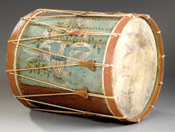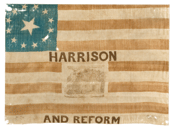|
Cowan's Corner
“Tippecanoe and Tyler Too” Still a Hot Ticket
By Wes Cowan
Before every election, we show our support for our favorites through yard-signs, bumper stickers, and lapel pins. This wasn’t always the case. In the early days of the Republic, electioneering was considered unseemly, and voters rarely showed their outward support for a candidate. The 1840 presidential election, pitting William Henry Harrison against Martin Van Buren, is considered by collectors and scholars to be the first election in which all this changed.
Harrison was a senior statesman and a native of North Bend, Ohio. He had been the Governor of the Territory of Indiana, a United States Congressman and Senator, and a military hero during the War of 1812, where he led an American military force to victory at the Battle of Tippecanoe. As a “westerner,” he saw the need for improving roads and canals, as well as public education. Harrison shared the belief of his Whig Party that Congress, not the executive branch, should exercise the greater power in decisions affecting the country.
When the Whig Party trotted him onto the National Scene, they played up his past military accomplishments and his rural background. They styled him as “The Hero of Tippecanoe” and “The Farmer from North Bend.” Harrison supporters produced a staggering diversity of ephemera. Flags, label ribbons and pins, buttons, ceramics, cigar cases, boxes and prints were made in large quantities. A surprising amount of these items have survived and frequent the market today. His ribbons go for figures in the hundreds while other pieces of memorabilia command much larger prices.
Political collectors especially prize flags made for his campaign, which have been known to garner tens of thousands of dollars at auction. Many include the slogan “Harrison and Reform,” as a reference to the unpopular policies of the outgoing president, Martin Van Buren. Others featured a depiction of a log cabin, often with an open door and a prominently visible cider barrel. The scene was completed by a uniformed figure of Harrison greeting a disabled veteran. This tableau was meant to play on Harrison’s supposedly humble beginnings as a Midwestern farmer with a door always open to veterans, who were welcomed with a drink of hard cider. This was not an accurate depiction of Harrison, who was never a Midwestern farmer and did not commonly greet veterans with hard cider.
Surprisingly, supporters of Martin Van Buren, a Democrat, produced relatively little in the way of campaign paraphernalia. Occasional ribbons, tokens and portrait paintings on glass are known, but electioneering for Van Buren did not incorporate the same range of material culture produced for his opponent. Perhaps his supporters felt it unnecessary. Van Buren was already a nationallyknown figure and had been for years. This makes memorabilia for Van Buren more difficult to find on the market.
The election was a disaster for the Democratic Party as Harrison garnered more than twice the popular vote. Ironically, Harrison never got a chance to implement the progressive policies that swept him to office. The old Whig delivered his inaugural address in a freezing rain and caught pneumonia. Harrison died 41 days after taking office.
Owning a piece of memorabilia from the first “modern” election is a must for any political or historical aficionado.
 About the author: Wes Cowan is founder and owner of Cowan’s Auctions, Inc. in Cincinnati, Ohio. An internationally recognized expert in historic Americana, Wes stars in the PBS television series History Detectives and is a featured appraiser on Antiques Roadshow. He can be reached via email at info@cowans.com About the author: Wes Cowan is founder and owner of Cowan’s Auctions, Inc. in Cincinnati, Ohio. An internationally recognized expert in historic Americana, Wes stars in the PBS television series History Detectives and is a featured appraiser on Antiques Roadshow. He can be reached via email at info@cowans.com
|

A
hand-painted William
Henry Harrison parade
drum, sold for $2,300.

A
William Henry Harrison
campaign flag, sold
for $15,000.
|